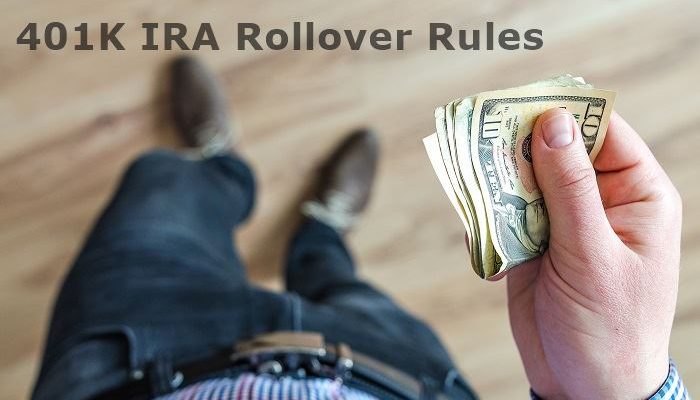What happens to your 401k plan when you leave your employer, or the organization leaves you? For most people, an attractive choice is to roll over their retirement funds from the 401K into an IRA.
A 401K IRA rollover is the right move for many reasons, but one of the main reasons people make the switch is to enjoy the increased flexibility of investment which comes with IRAs. IRAs also offer lower management fees and gives you more control over your investment decisions. However, it’s essential that you understand the rules of the Internal Revenue Service and the tax implications regarding the transfer of your funds from a 401K to an IRA.
Alternatives To Rollovers

What if you don’t want to roll over your retirement funds? Here are other options you can choose if you are not sure of doing a rollover:
• You can cash out. However, cashing is often a terrible mistake. If you cash out of a traditional 401K plan before the age of 59 1/2, you will have to pay taxes on your contributions as the IRS views the withdrawal as income which falls under its purview. You also suffer penalties for early withdrawals. There goes all your hard work and sacrifice over the years.
• You can leave the funds in your old employer’s plan. If your old 401K plan offers low fees and great investment opportunities, it’s better to leave the funds in the account.
• You can also transfer your retirement funds to your new employer’s 401K plan, especially if the new plan offers better investment choices and lower fees than the former. Be sure to ask your old plan’s administrator if you can roll over your account to a new plan.
What Are The Benefits Of An IRA?

Several types of IRAs offer some benefits you won’t find in any 401K plan. The first and most important benefit of IRAs over 401K is that they provide more investment opportunities. With IRAs, especially Precious Metals IRAs, you can invest in many assets outside of the traditional stocks market including real estate, private equities, gold, silver, commodities and so on.
In addition to greater diversification of your retirement portfolio, you can do more for less with IRAs as most custodians offer lower administration fees for all the benefits in an IRA. Additionally, IRAs provide more concessions if you need to make withdrawals from your retirement savings.
Here are some situations where you can make early withdrawals from an IRA:
• An IRA allows you to withdraw up to $10,000 without penalties before reaching the stipulated 59 1/2 years to finance a first-time home purchase.
• With an IRA, you can also withdraw money to pay for qualified college expenses without incurring any early withdrawal penalty.
• When the IRA owner suffers a disability.
• Upon the death of the holder of an IRA account, the beneficiary can withdraw the savings in the account.
• The IRA holder needs the money to cover hospital and insurance bills.
• When the IRA holder become unemployed and has no money to pay for insurance.
• When the account holder takes out the same amount of money known as substantially equal periodic payments spanning their life expectancy.
Rules Guiding Rollovers

Rollovers from one type of retirement account into another follow different rules and regulations, making it important to always check the tax implications before making any transfer. Generally, if you are transferring your money between accounts with similar tax rules, you won’t raise any tax issues.
Rollovers from classic 401K to Traditional IRA don’t throw up any tax matters since the two accounts are tax-deferred, and you only get to pay taxes on the money when you cash out after retirement. The same applies to a rollover from a Roth 401K to a Roth IRA as both are after-tax accounts and you don’t have to pay any tax at all when you start withdrawing the money after retirement.
However, a rollover from a 401K to a Roth IRA is problematic as you are moving pretax dollar into an after-tax account. To move your money from a 401K to a Roth IRA, you first need to roll over the money to a traditional IRA, and then you convert the account to a Roth IRA. What this implies is that you pay taxes on the funds when you transfer it to the IRA.
How To Rollover Your 401K To An IRA

Doing a rollover from your 401K account is simple. The first step is to open an IRA account. There are many banks, brokerages, and other financial institutions offering IRA accounts. It is important to choose an IRA provider with low fees and good track record. Once you have opened the IRA, inform your 401K plan administrator of your intention to roll over your funds to your new account. You can either do a direct or indirect rollover.
In a direct rollover, your 401K administrator sends the funds directly to your IRA account either by electronic transfer or check. This is the easier method, and you won’t pay taxes. But remember that you won’t pay taxes only if you are transferring from a tax-deferred account to another tax-deferred account. If you are moving your traditional 401K plan to a Roth IRA, you will pay taxes on the transfer.
After completing the paperwork, your funds will be rolled over to the IRA, and you can invest with it as you please.
In an indirect rollover, your employer issues a check for the value of your account with 20 percent held back for tax purposes. To avoid a tax penalty, you have to deposit the check in another retirement account such as a 401K or IRA within 60 days after which your withheld funds will also be returned to you.
People do an indirect rollover when they need to move their money out of their old retirement account but don’t have a place to deposit it at the moment. An indirect rollover can also be used as a short-term loan as it allows you to cash out your 401K plan without any tax penalties as long as you deposit the money into another retirement account within 60 days.
Contributions Limits
After opening an IRA, you can fund the account up to the annual limit of contributions. In 2017, the contribution limit for people who are 50 and above was $5,500-$6,500. There are different contribution limits for different retirement plans. Be sure to check out the contribution limits to avoid penalties.
Choosing An IRA Provider

The choice of an IRA provide depends on the type of investor you are. Do you prefer a more hands-on approach to investing or like to leave the job to your provider?
If you are not investment-savvy or don’t have the time and energy to research individual investments, you should choose a provider that can help you create a diversified portfolio that runs on autopilot. Several providers offer this service at a low cost. They help you build a personalized investment portfolio and continue to manage it over time to increase the size of your account at prices lower than what traditional investment managers would charge you.
If you prefer to be actively involved in the management of your portfolio, you can choose from the several online brokers that allow you to build a portfolio buying and selling a diverse range of low-cost assets.
A 401K IRA rollover is a great way to increase control of your retirement funds and diversify your investments. But whatever you do, don’t cash out. Cashing out defeats the purpose of the tax-deferred status of your retirement accounts and you will be losing the money that could have bought you a comfortable retirement to the taxman.
Our personal recommendation to safeguard your future with gold is to contact Regal Assets, The #1 Rated Gold Investment Company 7 years in a row, Click Here To Request A FREE Gold Investors Kit.




